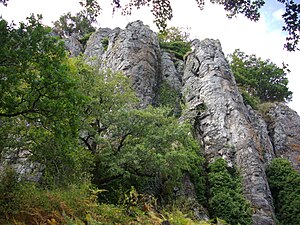Orgues de Bort
The Orgues de Bort are phonolithic separation columns near Bort-les-Orgues in the French department of Corrèze (Region Nouvelle-Aquitaine ).
geography
The Orgues de Bort, German organs from Bort or organ pipes from Bort , are part of a cooled lava flow west of Bort-les-Orgues. The surface of the river culminates at 859 meters above sea level in its exit point La Pyramide near the hamlet of Puy de Bort - a caldera - and towers over the valley of the Dordogne, cut into the crystalline basement by a good 400 meters. The actual 80 to 100 meters high and 2 kilometers further east located organ pipes only reach 764 meters. Its 1500 meter long steep face strikes north-northeast-south-southwest - roughly parallel to the Dordogne, which flows 800 meters further east. The height difference between the plateau edge and the river is 350 meters here. At the southern end of the steep face there is a cave and several troglodytic dwellings. On the plateau there is a botanical nature trail and a panoramic viewpoint ( French belvédère ) with a nearby kiosk, bar and parking lot, allowing an impressive panoramic view of the Monts Dore , the Artense and the Cantal in good weather .
geology
The lava flow was originally towards the valley of the Proto-Dordogne, which was much higher in the Miocene and flowed past a little west of Bort-les-Orgues. The Phonolithlava flowing to the east had accumulated over a short distance of only 1500 meters up to a river height of 80, maximum 100 meters on the opposite slope of the Proto-Dordogne. The Proto-Dordogne was thus effectively blocked and thereby forced to shift its course further east to its present position.
As a result of the cooling process, polygonal columns standing parallel to one another have formed, which are popularly known as volcanic organ pipes - rather seldom in Phonolith.
By reversing the relief, the lava flow was then carved out in its current dominant position due to the progressive erosion.
The lava flow was dated 8 to 6 million years ago as the end of the Miocene ( Tortonian / Messinian ) and petrologically consists of phonolite undersaturated with SiO 2 . The volcanic rock weathered off-white, but when fresh shows a persistent gray. Only blue and blackish hauynes and dark amphiboles can be recognized as phenocrystals . It comes from a lava stage on the northwest section of the Cantal , the largest stratovolcano in Europe. The phonolite lies on sediments of the Oligocene , which in turn are discordant on the Variscan basement . The caldera is underlain by Ussel granite , the central part of the lava flow is covered by the coal-bearing upper carbon of the Champagnac-Ydes coal basin belonging to the Sillon houiller and the eastern section rests on orthogneiss from the Artense series .
A special feature is the Ribeyrol phonolite - a smaller lateral lava flow that emanated from an 825 meter high secondary cone on the south side of the main river and emerged quite steeply to the south to the Dordogne, which flows here at 400 meters above sea level. He has at its sole dark glass skin and brekzifiziert. A corridor is suspected to be on the west side of the Phonolite River . Also of interest are two nearby breccia stumps , which are likely to belong to a phreatomagmatic diatreme . Among other things, they have plenty of granite fragments from the Ussel granite.
Also worth mentioning are several smaller neighboring basalt domes west of Madic , such as the Puy de Combret and the Puy de Couronne . They were formed during the initial basalt stage of the Cantal.
On the plateau, small moraine remnants with partly quite large erratic gneiss and basalt blocks were found, which show the glaciation of the Monts Dore and the Cantal.
Petrology
Petrologically, two facies and a transition area can be distinguished in the phonolite. The dark facies contain automorphically formed phenocrystals from Hauyn, which contain opaque minerals, small greenish clinopyroxenes , titanite and rare amphiboles in their core area . Adjusted alkali feldspar microliths and a large number of automorphic nepheline prisms swim in the matrix . The light facies are much richer in the elements iron and magnesium . The hauyn phenocrystals are yellowish and only rarely contain intersecting opaque minerals. Other phenocrystals are clinopyroxene (numerous), plagioclase (more rarely), apatite and amphibole prisms, which are girdled by clinopyroxene, alkali feldspar and opaque minerals. The dark facies is a tephritic phonolite that is found in the caldera area and at Puy de Bort . The light facies appear in the east at the lookout point. The transition facies lies between the two extremes.
ecology
Since 1933, the Orgues de Bort have been a classified nature reserve of type 1, known in French as ZNIEFF - Zone Naturelle d'Interêt Faunistique et Floristique . They are also included in Natura 2000 because of their fauna and flora, and especially because of their richness in bird species.
Sport climbing
On the left side of the wall of the lava flow, a total of 29 climbing routes have been designated, which can be climbed almost all year round and have French levels of difficulty from 3c to 6b3 (UIAA III to VII +).
Individual evidence
- ^ Pierre Lavina: Les Orgues de Bort . Artis Éditions, Paris 2003, p. 62 .
- ↑ Y. Veyret: Les modèles et formations d'origine glaciaire dans le Massif central français: problèmes de distribution et de limites dans un milieu de moyenne montagne . Press univ. Lille diff., 1981.
- ↑ MC Magonthier and D. Felde: Sur les phono lites de Bort-les-Orgues (Corrèze) . In: CR somme Soc. géol. Fr. 1. XVII, n ° 1, 1975.
Coordinates: 45 ° 23 '44 " N , 2 ° 28' 55" E



